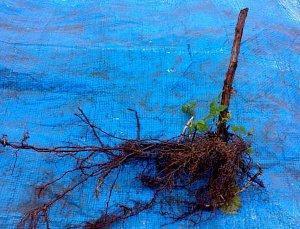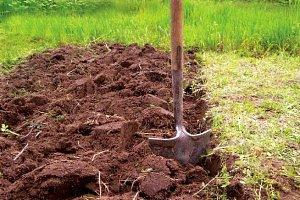Growing raspberries in the country
 Raspberry is a self-pollinating, perennial shrub, beloved by many gardeners, bearing aromatic, healthy and tasty berries.
Raspberry is a self-pollinating, perennial shrub, beloved by many gardeners, bearing aromatic, healthy and tasty berries.
Aerial part of the plant:
- young twigs that have grown this summer;
- shoots with dense, stiff bark, second year of life, it is on them that berries are formed.
Underground part:
- the root system with buds formed on it, from which shoots later grow - offspring;
- part of the trunk below the soil level with formed buds. Twigs emerging from such buds are replacement shoots;
- adventitious roots.
Reference! Raspberry berries contain various active components: fructose, glucose, fiber, pectins, coloring and tannins, B vitamins, carotene, potassium and copper salts, phytosterol, β-sitosterol. And also, there are acids: formic, citric, salicylic, folic, malic. Due to such a rich composition, the berries have pronounced antiseptic and antipyretic properties.
Read also the article about the raspberry tree!
Agricultural technology for growing raspberries

Site preparation
Important! Both dry high areas and places with excessive soil moisture (lowlands, ravines) are not suitable for raspberries. In both the first and second cases, the plants suffer from various diseases, which significantly reduces the yield. This culture grows well, develops and bears fruit on light and medium drained loams, as well as sandy loam soils with a supply of humus, water and mineral elements.
The location and features of the site are important factors that gardeners should pay attention to in order to increase yields when growing raspberries:
- first of all, the place under the raspberry tree should be well ventilated, but not open to all winds. It is advisable to choose a site in the corner of the garden or where the bushes on one side will close fence or any wall, here, however, there is one caveat - the bushes are planted no closer than 50 cm to one-sided protection (wall, fence). In this case, the plants are freely blown by air masses, and at the same time they do not suffer from strong gusts of wind;
- when planning a raspberry plant, agricultural technicians recommend arranging rows of bushes from the north-east side to the south-west or from the north to the south;
- shading and flaw lighting, for example, when planting in the aisles of trees, it is also not good, since under such conditions, young branches (replacement shoots and offspring) are extremely stretched in growth, shading the fruiting branches. Accordingly, the growth period, as well as the growing season, is significantly delayed and the plant does not have time to fully prepare for the cold weather, in addition to this, the risk of diseases increases;
Advice! Seasoned gardeners advise planting rows of raspberries along the paths in the front garden or near the gate. Here, as a rule, it is always quite light, and there is more care for raspberries due to the fact that the plants are constantly "in sight".
 The soil. Before planting raspberries, soil preparation includes digging, loosening and timely fertilization:
The soil. Before planting raspberries, soil preparation includes digging, loosening and timely fertilization:
- the selected area is dug to a depth of 32 cm (the average length of the shovel bayonet) or slightly more;
- weeds are removed;
- fertilizers are applied - on a plot of 3 m², a mixture of 12 kg of humus, 80 g of potassium and 170 g is prepared superphosphate;
- the earth is dug up again, then loosened;
- trenches or holes for bushes are being prepared. The planting scheme may be different, this indicator depends on the selected variety and the arrangement of the rows (one or several parallel to each other) - 2.5 × 0.5 m, 1.8 × 0.7 m.
Read:raspberry remontant - care and cultivation.
Growing raspberries from seeds
Important! When growing raspberries from seeds, it is necessary to take into account that no more than 50% of all planted material will germinate, and the characteristics of the resulting plants can differ significantly from the parent ones. As a rule, this method is used by breeders to develop new varieties.
Receiving seed
- In order to obtain high-quality seed and thereby increase germination, it is necessary to select only ripe, and even better overripe berries.
- Gently squeeze the juice out of the berries; for this purpose, you can use a fine strainer.
- Put the resulting pulp into a container and pour cool water. Mix. After that, the dummy seeds will float up, they can be safely thrown away. Repeat the procedure 5 times.
- Dry the seeds in a warm, ventilated place. In doing so, care must be taken that direct sunlight does not fall on the seed.
Planting seeds
- The technology of growing raspberries from seeds depends on the sowing time, i.e. in spring or autumn:
- autumn - sowing is carried out in open ground, the seeding depth is 2 cm, the seeds are covered with a mixture of sand and humus, the components are taken in equal quantities;
- spring - the best results are obtained by preliminary germination of seeds in a regular seedling container. The soil substrate is prepared from sand, garden soil and peat, all components should be in a 1: 1 ratio. Sowing depth in a box is 4–6 mm. Further, regular watering is carried out with water 1 time in 4 days and fertilization with a solution urea once a decade.
- Planting seedlings sprouted at home in open ground, is carried out in prepared soil, according to the usual scheme.
Advice! Want to get good harvests but live in a northern region with cold, short summers? - Try growing raspberries in a greenhouse. Such a technique will allow you to achieve as close as possible to the ideal temperature regime for this culture.

Growing raspberries according to the Sobolev method
The main difference between growing raspberries according to the Sobolev method, from the traditional method, is pruning branches, which is done in two stages:
- Spring (end of May) - the tops of last year's branches, in particular, lateral and central shoots, are cut by 5-14 cm. This procedure contributes to the formation of a larger number of peduncles, an increase in yield and a significant lengthening of the fruiting period.
- Autumn - the tops are trimmed to a well-developed bud (about 8-14 cm) in the germinated shoots of the first-year, length trimming depends on the variety.
Such an agrotechnical method contributes to the formation of a bush, facilitates care and enhances the growth of the remaining branches. And what is important, additional buds wake up on the cut shoots, from which laterals (lateral branches) are formed.

How to properly grow raspberries according to the Sobolev method - tips and nuances
Gardeners are often interested in questions: How to properly grow raspberries according to the Sobolev method? What difficulties and nuances can arise with this method of growing raspberries? What should be done and when, and what should not be categorically?
And so, in order - tips and tricks:
- The first, spring pruning - timeliness, that's the main word in this procedure. The best time is the last days of May, the tops of the shoots are cut off, the height of which is in the range from half a meter to a meter. During the period remaining before the cold weather, 4–6 upper remaining buds will wake up and develop into lateral shoots, and what is very important, the buds that appear on the laterals will also have time to mature and get ready for winter.
- Selecting a variety - you should be aware that the method is designed primarily for:
- varieties with a low ability to shoot;
- 3-4 year old plants;
- senescent, with low formation of shoots, plants.
Varieties with intensive growth of a large number of suckers and replacement shoots, before using the Sobolev method, require significant thinning.The thickening of the bushes significantly reduces the effectiveness of the method and contributes to the development of diseases such as rot and purple spot, as well as damage to plants by stem gall midge and raspberry flies.

Basic rules for caring for raspberries according to Sobolev:
- Despite the fact that the culture prefers moist soil, excessive waterlogging is unacceptable, as this leads to decay of the root system, the appearance of diseases and stretching of branches. To maintain the required water balance, mulching fresh horse or cow manure... A layer of mulch 15 cm thick, distributed over the soil near the raspberry bushes, after spilling with water, forms a dense crust, which perfectly retains moisture and decomposes over time, serves as an excellent fertilizer for the plant.
Advice! If it is not possible to purchase manure, mulching can be done with peat, shavings, sawdust or compost.
- In the spring and early summer, the soil under the raspberry tree should be loosened. This must be done very carefully, touching the soil layer to a depth of no more than 3 cm, otherwise you can damage the root system and young, delicate shoots.
- In the fall, before wintering, all the plants are bent to the ground (the distance from the branches to the soil is 40 cm), pinned with wooden slingshots and covered with covering materials.
- Every 2-3 years it is necessary to apply top dressing to the soil; humus, manure and mineral fertilizers... When combined, i.e. simultaneous application of organic and mineral fertilizers, agricultural technicians advise the doses of both to be halved, per 1 m² - 3 g of nitrogen, 1.6 kg of manure, 4 g of potassium and 3 g of phosphorus.
Read also the article:how to properly cut raspberries in the spring (diagram)